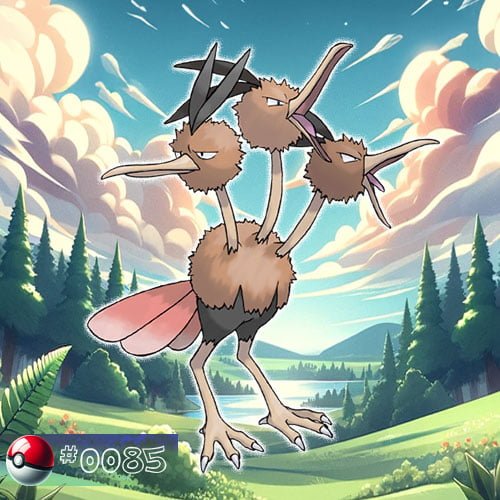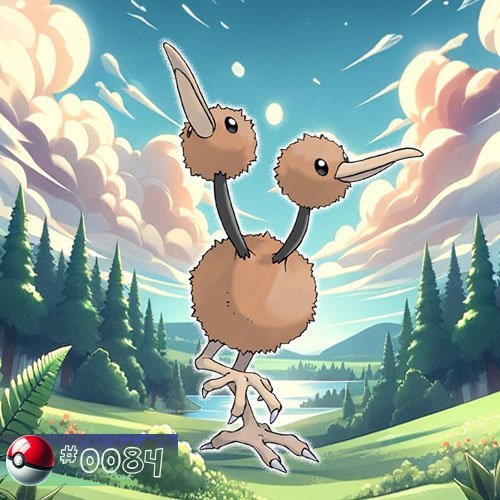Dodrio
Dodrio is a Normal/Flying-type Pokémon known for its distinctive three heads and enhanced agility. Dodrio evolves from Doduo starting at level 31. In Pokémon lore, Dodrio is recognized for its speed, versatility, and unique appearance with three heads and a powerful, streamlined body.
Biology
Physical Characteristics
Dodrio is a tall Pokémon, standing at approximately 5 feet 11 inches (1.8 meters). Dodrio features three heads, each with its beak, eyes, and neck. The three heads provide Dodrio with a wide field of vision, enhancing its overall awareness. Each head has a long, pointed beak. These beaks are strong and sharp, allowing Dodrio to grasp and manipulate objects, as well as defend itself in battles. Dodrio may have distinct facial markings around its eyes and beaks, adding to its overall visual appeal.
Dodrio’s feathers are soft and provide insulation. The texture of the feathers may vary, with some areas having downy feathers for added warmth. Dodrio’s feathers have a mix of brown, beige, and cream colors. The arrangement of these colors adds to its unique and eye-catching appearance.
Dodrio has a set of wings on its body. While it cannot achieve sustained flight, the wings allow Dodrio to make short flights and glide over short distances. Dodrio has a streamlined and aerodynamic body, reducing air resistance during its short flights.
Dodrio’s legs are robust and muscular, providing the necessary strength for running at high speeds. The legs end in three-toed feet, each with sharp talons. Dodrio has a short, stubby tail that adds to its balance and stability, particularly during rapid movements.
Dodrio inherits the swift and agile nature of Doduo, making it a fast runner. Its triple-headed structure contributes to its ability to react quickly to its surroundings. The three heads of Dodrio work in coordination, allowing it to perform complex movements and actions. This coordination is beneficial in both battles and other activities. Dodrio is relatively lightweight, contributing to its agility and allowing for rapid acceleration during sprints.
Dodrio’s evolution from Doduo introduces a third head and an extra pair of wings. This evolutionary advancement enhances Dodrio’s sensory perception and mobility.
These physical characteristics collectively define Dodrio’s unique and striking appearance, highlighting its adaptability for both ground-based and short aerial activities in the Pokémon world.
Behaviour
Dodrio’s behavior is influenced by its triple-headed structure, evolutionary adaptations, and its role in the Pokémon ecosystem. Here are detailed aspects of Dodrio’s behavior.
Dodrio often lives in groups or flocks, similar to its pre-evolution Doduo. Within these groups, Dodrio exhibits social behavior, such as coordinating movements and cooperating in various activities. The three heads of Dodrio are capable of communicating with each other, allowing for effective coordination during tasks, battles, or group activities.
Dodrio may engage in territorial behavior, marking its habitat with vocalizations, visual displays, and possibly scent markings. This behavior helps establish and defend its territory. Dodrio is primarily carnivorous, feeding on small prey such as insects, small mammals, and other Pokémon. Its triple-headed structure provides a strategic advantage during hunting, enabling it to spot prey from multiple angles. Dodrio’s three heads work together during hunting, allowing for effective coordination and strategizing to capture prey.
Dodrio is known for its remarkable running speed. The powerful legs of each head contribute to its agility, allowing it to cover large distances quickly. While Dodrio cannot achieve sustained flight, it uses its wings for short flights and gliding. This behavior enhances its mobility, enabling it to navigate various terrains.
Dodrio’s triple-headed structure provides it with an expanded field of vision and heightened awareness. This adaptability allows Dodrio to detect potential threats or opportunities from different directions. Dodrio exhibits protective behavior within its group. If a member of the flock is threatened, Dodrio will actively defend and support its companions.
Dodrio is primarily active during the day (diurnal), aligning its behavioral patterns with the natural day-night cycle.
Dodrio may interact positively with other Pokémon within its group, establishing social bonds and cooperative relationships. While Dodrio can work well with its own kind, there might be instances of competition or rivalry within the group, especially during hunting or territorial disputes. Dodrio may exhibit curiosity towards humans but is generally cautious. It may observe human activities from a distance, especially if humans are within its territory.
Understanding Dodrio’s behavior provides insights into its survival strategies, social dynamics, and ecological role within the Pokémon world. Its triple-headed nature contributes to effective communication and cooperation, making it a fascinating species in the Pokémon universe.
Evolution
Dodrio is the evolved form of Doduo, and its evolution process involves the following details.
Doduo is a dual-type Normal/Flying Pokémon with two heads. It Doduo has a brown, bird-like body with two heads, each featuring a long neck and a pointed beak. It has small, vestigial wings that do not allow for flight. Doduo evolves into Dodrio starting at level 31. This evolution is triggered by gaining experience points through battles, training, or using certain items like Rare Candies.
Dodrio is also a dual-type Normal/Flying Pokémon, maintaining its Flying-type from Doduo. The most notable change in Dodrio is the emergence of a third head, creating a tri-headed structure. Dodrio also gains an extra pair of wings, although it is still unable to achieve sustained flight.
Dodrio’s three heads provide it with enhanced awareness, allowing it to observe its surroundings from multiple angles simultaneously. The additional pair of wings on Dodrio’s body is larger than the vestigial wings on Doduo. While Dodrio still can’t fly in the traditional sense, the wings allow for short flights and gliding. With the addition of a third head, Dodrio’s coordination abilities are enhanced. This can be advantageous in group activities, hunting, and navigating its environment.
While Dodrio remains primarily grounded, it can use its wings for short flights, allowing it to cover short distances by gliding. This provides Dodrio with an additional mode of mobility compared to Doduo.
Dodrio generally experiences an increase in its base stats upon evolution, making it stronger and more resilient compared to Doduo. Dodrio may learn new moves or abilities upon evolution, expanding its tactical options in battles.
Dodrio’s evolution into Dodrio enhances its versatility in battles and other Pokémon-related activities. Trainers may find Dodrio to be a valuable addition to their teams due to its improved capabilities. In the Pokémon world, the evolution of Doduo into Dodrio is often seen as a testament to the species’ adaptability and survival traits. The addition of a third head is a fascinating aspect of Dodrio’s evolution that captivates trainers and researchers alike.
Understanding Dodrio’s evolution from Doduo provides trainers with insights into the species’ growth, adaptation, and the unique features that emerge as it progresses through its life cycle.
Appearances
Anime Main Appearances
In ”The Flame Pokémon-athon!”, Dario entered the Big P Pokémon Race with his Dodrio. However, Ash, riding Lara Laramie’s Ponyta, emerged victorious, later evolving into Rapidash. Numerous other Dodrio were spotted at the Laramie Ranch during the event.
Falkner’s Dodrio clashed with Ash’s Pikachu in ”Fighting Flyer with Fire”, initially dominating but ultimately defeated as Ash cleverly employed Falkner’s strategy against him. In ”Putting the Air Back in Aerodactyl!”, Gary’s evolved Dodrio thwarted Butch and Cassidy’s plans. In ”Pokémon Ranger and the Kidnapped Riolu! (Part 2)”, Ash, Kellyn, Dawn, and Brock each rode a Dodrio to rescue the kidnapped Riolu from Team Galactic’s clutches.
Anime Minor Appearances
Dodrio made its first appearance in the Pokémon anime during “Pokémon – I Choose You!” where it was seen crowing in Pallet Town. Notably, it marked the first physical appearance of a Pokémon in the anime, as previous encounters were either on TV, in dreams, or not actual entities.
Dodrio also makes numerous other appearances across various Pokémon episodes:
- Featured in “Primeape Goes Bananas” and “Pokémon Fashion Flash”.
- Played a role in episodes like “The March of the Exeggutor Squad”, “A Chansey Operation”, and “The Case of the K-9 Caper!”.
- Used by Stella in her circus during “It’s Mr. Mime Time”.
- Ridden by Tracey in a flashback in “The Lost Lapras”.
- Seen in diverse situations, from Pokémon breeding competitions (”Beauty and the Breeder”) to Extreme Pokémon Race (”Extreme Pokémon!”).
- Made cameo appearances in movies like “Pokémon Ranger and the Temple of the Sea”.
- Participated in events like the Pokémon Triathlon (”One Team, Two Team, Red Team, Blue Team!”) and served as transportation in various locations.
- Notably featured in “Legend? Go! Friends? Go!” and “The Rainbow and the Pokémon Master!”.
Multiple Dodrio appeared in the espiodes:
- ”Plant It Now…Diglett Later” (acted as steeds for the Band of Diglett thieves)
- ”Destiny Deoxys” (in the opening sequence)
- ”Historical Mystery Tour!” (seen by Barry, a Pokémon Trainer from Twinleaf Town and one of Ash’s rivals, in Xatu’s Forest)
A Trainer’s Dodrio appeared also in the following epsodes:
- ”When a House is Not a Home!”
- ”Sleuths for Truth!”
- ”Aim For The Eight!”
Manga Appearances
Magical Pokémon Journey
In “Panic at the Cherry Blossom Festival”, a Dodrio was present, becoming intoxicated on amazake and creating chaos at a cherry blossom festival attended by Hazel, the main character of this manga and her friends.
Pokémon Adventures
In “Just a Spearow Carrier,” Professor Oak, posing as Dr. O, employed Dodrio in a battle against Green during the semifinals to exploit her fear of birds.
Yellow’s Doduo underwent evolution into Dodrio in “The Might of… Metapod?!” during a clash with Lance. Dodrio later played a crucial role in rescuing Pika and Chuchu from a surfing mishap. Serving as Yellow’s primary mode of swift transportation, Dodrio’s rapid speed remains instrumental in their journeys.
In other various chapters of this Pokémon manga:
- Dodrio participated in ”The Last Battle XIII” in the fight at Ilex Forest.
- In ”Old Ultima Puts Them to the Test”, Ultima utilized Dodrio for the Path of Catching trial with Red and Blue.
- A Dodrio from the Battle Factory featured in ”Interesting Interactions Involving Illumise”.
- The Battle Tower rented a Dodrio, stolen by Guile Hideout in ”The Final Battle VII”.
- In ”Out-Odding Oddish”, Jet used a Dodrio in the Pokéathlon’s Speed Course against Gold, and another Trainer employed one.
- ”Weavile Wobbles But It Won’t Fall Down” showcased a Trainer’s Dodrio at the Safari Zone.
Pokémon Pocket Monsters
In this manga, Professor Oak’s Dodrio first appeared in “Save the Pokémon Zoo!!”. And another Dodrio was present at ”Pikachu’s Birthday Party”.
Pokémon Ranger the Comic: Double Mission
Similar to the games, Dodrio serves as Joel’s Partner Pokémon in Pokémon Ranger the Comic: Double Mission manga.
Game data
Stats
Location
| Game version | Location |
|---|---|
| Pokémon Red and Pokémon Blue | Cerulean Cave |
| Pokémon Yellow | Route 17 |
| Pokémon Gold | Routes 26 and 28, Mt. Silver |
| Pokémon Silver | Routes 27 and 28, Mt. Silver |
| Pokémon Crystal | Routes 27 and 28, Mt. Silver |
| Pokémon Ruby and Pokémon Sapphire | Safari Zone |
| Pokémon FireRed and Pokémon LeafGreen | Evolve Doduo |
| Pokémon Emerald | Safari Zone |
| Pokémon Colosseum | Trade |
| Pokémon XD | Citadark Isle |
| Pokémon Diamond and Pokémon Pearl | Evolve Doduo |
| Pokémon Platinum | Evolve Doduo |
| Pokémon HeartGold | Routes 26 and 28, Blackthorn City, Mt. Silver |
| Pokémon SoulSilver | Routes 27 and 28, Blackthorn City, Mt. Silver |
| Pokémon Black and Pokémon White | Evolve Doduo |
| Pokémon Black 2 and Pokémon White 2 | Evolve Doduo |
| Pokémon X and Pokémon Y | Evolve Doduo |
| Pokémon Omega Ruby and Pokémon Alpha Sapphire | Evolve Doduo |
| Pokémon Sun and Pokémon Moon | Pokémon Bank |
| Pokémon Ultra Sun and Pokémon Ultra Moon | Pokémon Bank |
| Pokémon: Let's Go, Pikachu! And Pokémon: Let's Go, Eevee! | Routes 16, 17, and 18 |
| Pokémon Sword and Pokémon Shield | Unobtainable |
| Pokémon Brilliant Diamond and Pokémon Shining Pearl | Evolve Doduo |
| Legends Arceus | Unobtainable |
| Pokémon Scarlet and Pokémon Violet | Trade |
Dodrio's origin name
The name “Dodrio” is consistent across various languages, maintaining its general pronunciation and often incorporating elements related to its triple-headed nature or its swift and nimble characteristics.
English: Dodrio – The English name “Dodrio” is a continuation of its pre-evolution Doduo, maintaining a connection to its dual-headed origin while highlighting the addition of the third head.
Japanese: ドードリオ (Dodorio) – In Japanese, Dodrio is referred to as “Dodorio,” which is a phonetic transcription of the English name.
German: Dodri – The German name for Dodrio is “Dodri,” maintaining the phonetic similarity to its English counterpart.
French: Dodrio – Similar to German, the French name for Dodrio is also “Dodrio,” staying true to the original English name.
Spanish: Dodrio – In Spanish, Dodrio retains its English name, being called “Dodrio.”
Italian: Dodrio – Similarly, in Italian, Dodrio is known by the same name, “Dodrio.”
Korean: 두트리오 (Dudeurio) – The Korean name for Dodrio is “Dudeurio,” which is a phonetic adaptation of the English name.
Chinese (Simplified): 嘟嘟利 (Dūdūlì) – In Simplified Chinese, Dodrio is referred to as “Dūdūlì,” a phonetic representation of its English name with additional characters.
Chinese (Traditional): 嘟嘟利歐 (Dūdūlì’ōu) – The Traditional Chinese name for Dodrio is “Dūdūlì’ōu,” maintaining a closer phonetic resemblance to the English name with additional characters.
These variations in names across languages often aim to preserve the key aspects of Dodrio’s identity, such as its triple-headed nature or its bird-like characteristics. The names may also reflect linguistic considerations and cultural nuances in each region.




